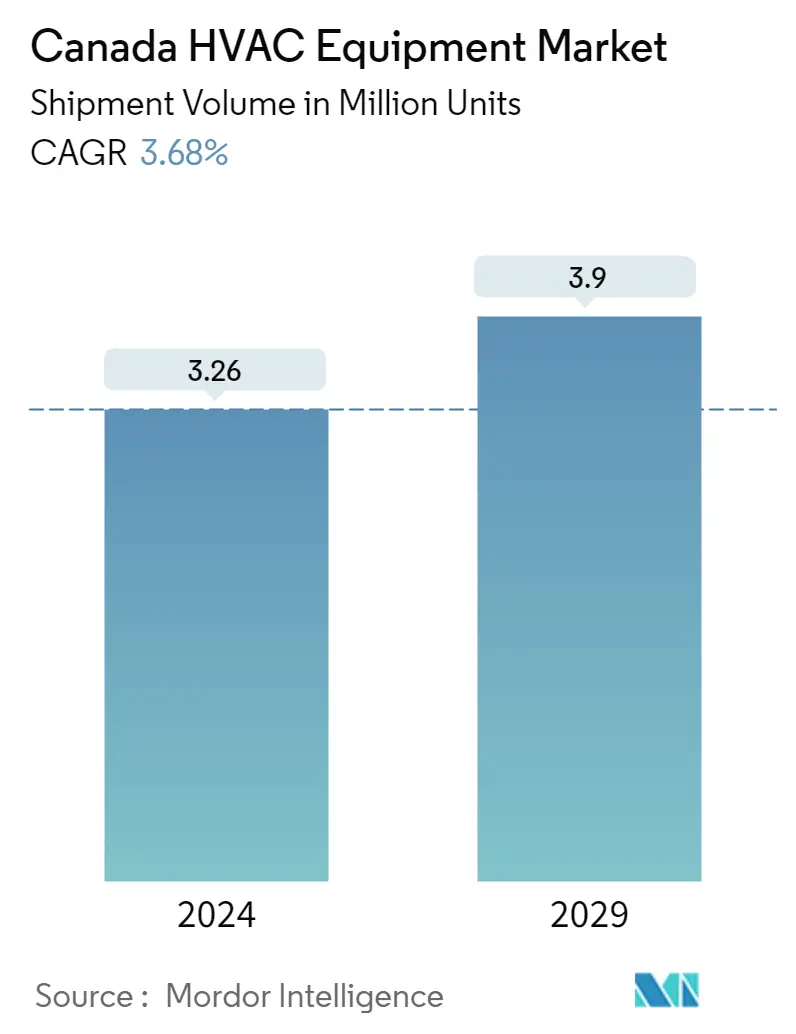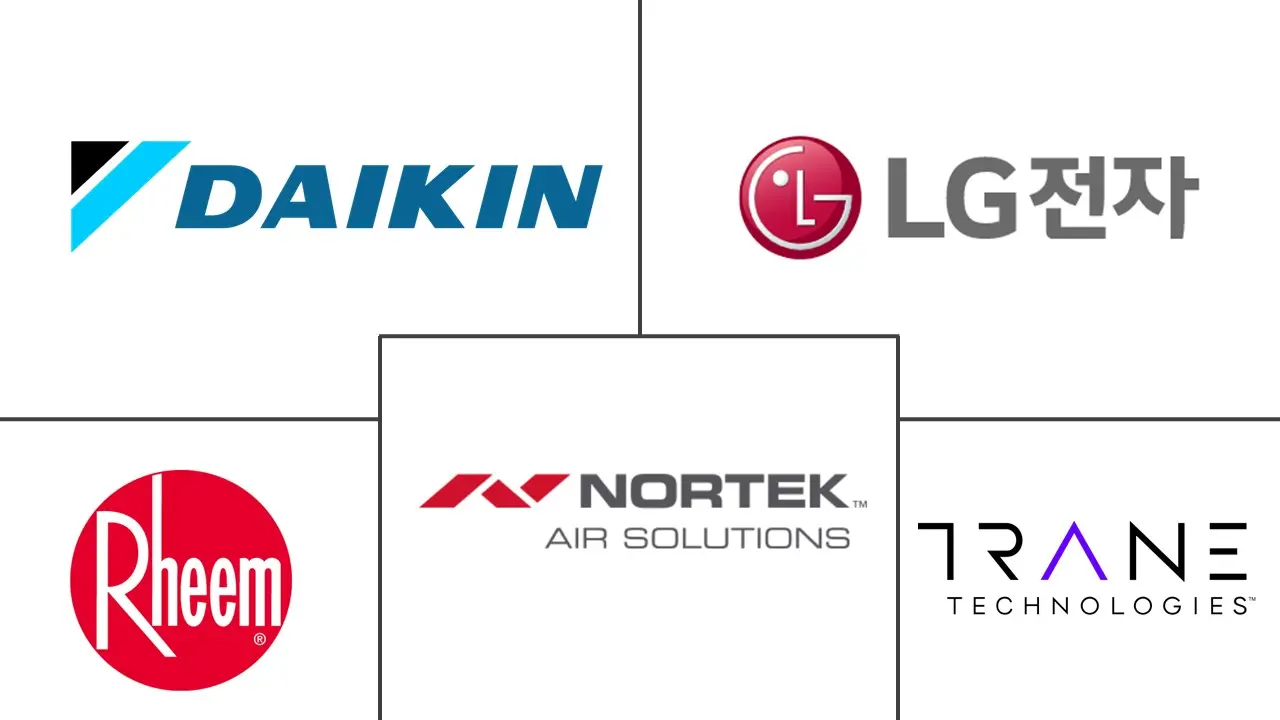Market Size of Canada HVAC Equipment Industry

| Study Period | 2019 - 2029 |
| Base Year For Estimation | 2023 |
| Market Volume (2024) | 3.26 Million units |
| Market Volume (2029) | 3.9 Million units |
| CAGR (2024 - 2029) | 3.68 % |
| Market Concentration | Low |
Major Players
*Disclaimer: Major Players sorted in no particular order |
Canada HVAC Equipment Market Analysis
The Canada HVAC Equipment Market size in terms of shipment volume is expected to grow from 3.26 Million units in 2024 to 3.9 Million units by 2029, at a CAGR of 3.68% during the forecast period (2024-2029).
Heating, ventilation, and air conditioning (HVAC) equipment are systems for circulating air between indoor and outdoor areas and heating and cooling in residential and commercial buildings. These techniques also filter and clean indoor air and maintain humidity at optimal levels. Government initiatives, such as rebates and tax incentives for energy-efficient HVAC installations, encourage consumers and businesses to invest in newer, more efficient systems. Also, increasing awareness of the importance of indoor air quality and its impact on health is driving the demand for HVAC systems with advanced filtration and ventilation capabilities across the country.
- There are initiatives in Canada offering rebates for installing energy-efficient equipment such as heating systems and heat pumps. Islanders can access both the Government of Canada's Greener Homes Grant and efficiency PEI rebates. Citizens who fall below the income level of CAD 35,000 are eligible for larger rebates. In May 2023, the Canadian government and the province of Manitoba joined forces to provide millions to upgrade ventilation, heating, and cooling equipment (HVAC) in Manitoban schools and healthcare facilities. These initiatives are likely to boost the growth of HVAC systems.
- With the country aiming for net-zero emissions by 2050, the Canadian government is encouraging the adoption of energy-efficient HVAC devices, such as heat pumps, air conditioners, and others, which is another primary market growth driver. As a result, large HVAC vendors are active in the region, and their numerous investments in new product launches are assisting the government in meeting its objectives.
- Further, in terms of heating equipment, though most Canadian households use forced-air heating systems to warm their homes, the demand for heat pumps, which are more energy-efficient than air furnaces, is expected to rise significantly in the coming years. This is driven by favorable government initiatives promoting heat pump adoption. Additionally, ventilation equipment, such as air handling units, is becoming popular as air pollution levels grow and people become more conscious of maintaining a healthy and safe atmosphere.
- The need to upgrade existing buildings with more efficient HVAC systems to reduce energy consumption and operational costs contributes to market growth. For instance, in November 2023, a joint investment of more than USD 384,000 was made to support retrofits to the Carnegie Building in Saint John. Announced by MP Wayne Long and Mayor Donna Reardon, this project will significantly help to reduce the facility's carbon footprint. The investment will help improve the heating, ventilation, and air conditioning (HVAC) system throughout Carnegie Building, creating significant energy savings for a cultural landmark of the city.
- Canada is also witnessing significant vendor activities in terms of air source heat pump technology. For instance, in December 2023, Terravis Energy, a subsidiary of Worksport Ltd, a Canadian technology company, unveiled a prototype of a residential air source heat pump designed for heating and cooling purposes. The heat pump boasts a coefficient of performance (COP) of approximately 1.8 and a seasonal coefficient of performance (SCOP) of around 3.0. Currently, the prototype utilizes R32 refrigerant, which has a global warming potential (GWP) of 675. Worksport Ltd mentioned that it aligned with the new 2024 mandate in Canada, which requires refrigerants to have a GWP of 750 or lower. These significant advancements will be crucial in determining the region's future availability of heat pump technology.
- According to the International Energy Agency (IEA), Canada is considering requiring energy performance better than a factor of 1 (corresponding to an equipment efficiency of 100%) for all heating systems by 2030, thereby banning all conventional coal-oil and gas-fired boilers. Such activities are anticipated to stimulate the demand for Heat pumps in the Canadian market.
- According to a research article from the Journal of Exposure Science and Environmental Epidemiology published in 2023, out of 4,500 respondents in Canada, 90% had mechanical ventilation devices over the cooktop (66% of which were vented to the outside), and 30% reported regularly using their device. Amidst increasing wildfires and rising toxic pollution levels during such disasters, there is an increasing need for exhaust and air filtration systems.
- Manufacturers are facing many efficiency requirements and changes to refrigerants that are primarily driven by the US Department of Energy (DOE), which has a significant impact on the market in Canada. New DOE energy efficiency standards for 2023 were expected to significantly impact all rooftop units sold in Canada. Moreover, the filters, coils, and fins, among others, of an HVAC system, such as an air conditioner, require regular maintenance for the equipment to work efficiently and effectively throughout its operating life. Neglecting necessary maintenance will reduce air conditioning performance and significantly increase energy consumption.
- The conflict between Russia and Ukraine is expected to impact the electronics industry significantly. The conflict might cause extra disruptions and affect the supply chains of semiconductors, leading to further increases in the prices of electronics. Overall, the impact of the conflict on the electronics industry is expected to be significant. This would hamper the production of the country's HVAC equipment.
Canada HVAC Equipment Industry Segmentation
HVAC equipment is a comfort technology for indoor and vehicle environments that provides thermal comfort and acceptable indoor air quality. This applies to residential buildings such as apartments, single-family homes, hotels, and elderly communities, as well as medium- and large-scale industrial buildings such as clinics, where safe and healthy building conditions are controlled in terms of temperature and humidity. It is also essential for office buildings as it adjusts humidity using fresh air from outside.
The Canada HVAC equipment market is segmented by type of equipment (air conditioning {ducted split systems, ductless split systems, packaged units and rooftops, chillers, and unit heaters}, heating {warm air furnaces [gas, electric, oil, and combination], and heat pumps}, ventilation {air handling units}), and end-user industry (residential and commercial). The report offers market forecasts and sizes in terms of volume (shipment in units) for all the above segments.
| By Type of Equipment | |||||||
| |||||||
| |||||||
|
| By End-user Industry | |
| Residential | |
| Commercial |
Canada HVAC Equipment Market Size Summary
The Canadian HVAC equipment market is poised for significant growth, driven by a combination of government initiatives, technological advancements, and increasing awareness of indoor air quality. The market is characterized by a strong push towards energy-efficient systems, supported by rebates and tax incentives for installations that meet stringent energy standards. The government's commitment to achieving net-zero emissions by 2050 is a major catalyst, encouraging the adoption of heat pumps and other energy-efficient HVAC devices. This regulatory environment, coupled with rising urbanization and the expansion of the construction sector, is fueling demand for HVAC systems in both residential and commercial spaces. The market is also witnessing a surge in vendor activities, with companies investing in new product launches and collaborations to enhance their offerings and meet evolving consumer needs.
The construction sector's growth, alongside government-backed retrofitting projects, is further propelling the demand for HVAC equipment. As new residential, commercial, and industrial projects emerge, the need for efficient heating, cooling, and ventilation systems becomes paramount. The increasing focus on sustainable building practices, such as the Net Zero guidelines, is driving the adoption of energy-efficient HVAC solutions. Additionally, the rising number of luxury residential projects and the need to comply with stricter emission regulations are contributing to market expansion. Despite challenges such as supply chain disruptions and the impact of global conflicts, the Canadian HVAC market remains robust, with key players actively engaging in strategic partnerships and technological innovations to maintain a competitive edge.
Canada HVAC Equipment Market Size - Table of Contents
-
1. MARKET INSIGHTS
-
1.1 Market Overview
-
1.2 Industry Attractiveness - Porter's Five Forces Analysis
-
1.2.1 Threat of New Entrants
-
1.2.2 Bargaining Power of Buyers
-
1.2.3 Bargaining Power of Suppliers
-
1.2.4 Threat of Substitute Products
-
1.2.5 Intensity of Competitive Rivalry
-
-
1.3 Industry Value Chain Analysis
-
1.4 Impact of Macroeconomic Trends on the Market
-
-
2. MARKET SEGMENTATION
-
2.1 By Type of Equipment
-
2.1.1 Air Conditioning
-
2.1.1.1 Ducted Split Systems
-
2.1.1.2 Ductless Split Systems
-
2.1.1.3 Packaged Units and Rooftops
-
2.1.1.4 Chillers
-
2.1.1.5 Unit Heaters
-
-
2.1.2 Heating
-
2.1.2.1 Warm Air Furnaces (Gas, Electric, Oil, and Combination)
-
2.1.2.2 Heat Pumps
-
-
2.1.3 Ventilation
-
2.1.3.1 Air Handling Units
-
-
-
2.2 By End-user Industry
-
2.2.1 Residential
-
2.2.2 Commercial
-
-
Canada HVAC Equipment Market Size FAQs
How big is the Canada HVAC Equipment Market?
The Canada HVAC Equipment Market size is expected to reach 3.26 million units in 2024 and grow at a CAGR of 3.68% to reach 3.9 million units by 2029.
What is the current Canada HVAC Equipment Market size?
In 2024, the Canada HVAC Equipment Market size is expected to reach 3.26 million units.

